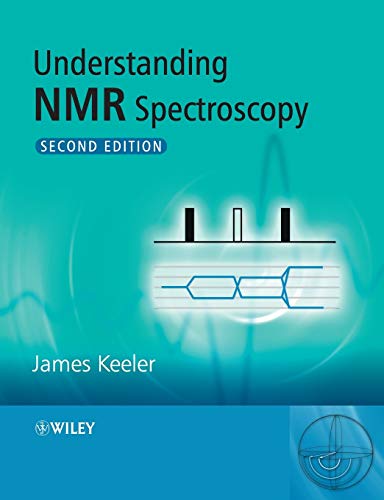
2010, ISBN: 0470746084
[EAN: 9780470746080], Neubuch, [PU: John Wiley & Sons Inc, New York], Paperback. This text is aimed at people who have some familiarity with high-resolution NMR and who wish to deepen the… Mehr…
| AbeBooks.de AussieBookSeller, Truganina, VIC, Australia [52402892] [Rating: 5 (von 5)] NEW BOOK. Versandkosten: EUR 34.39 Details... |

2013, ISBN: 9780470746080
[ED: Taschenbuch], [PU: John Wiley & Sons Inc], Neuware - This text is aimed at people who have some familiarity with high-resolution NMR and who wish to deepen their understanding of how… Mehr…
| booklooker.de |

2013, ISBN: 9780470746080
[ED: Taschenbuch], [PU: John Wiley & Sons Inc], Neuware - This text is aimed at people who have some familiarity with high-resolution NMR and who wish to deepen their understanding of how… Mehr…
| booklooker.de |

Understanding NMR Spectroscopy | James Keeler | Taschenbuch | 526 S. | Englisch | 2010 | John Wiley & Sons | EAN 9780470746080 - Taschenbuch
2010, ISBN: 9780470746080
[ED: Taschenbuch], [PU: John Wiley & Sons], This text is aimed at people who have some familiarity with high-resolution NMR and who wish to deepen their understanding of how NMR experimen… Mehr…
| booklooker.de |

Understanding NMR Spectroscopy / James Keeler / Taschenbuch / 526 S. / Englisch / 2010 / John Wiley & Sons / EAN 9780470746080 - Taschenbuch
2010, ISBN: 9780470746080
[ED: Taschenbuch], [PU: John Wiley & Sons], This text is aimed at people who have some familiarity with high-resolution NMR and who wish to deepen their understanding of how NMR experimen… Mehr…
| booklooker.de |


2010, ISBN: 0470746084
[EAN: 9780470746080], Neubuch, [PU: John Wiley & Sons Inc, New York], Paperback. This text is aimed at people who have some familiarity with high-resolution NMR and who wish to deepen the… Mehr…

2013, ISBN: 9780470746080
[ED: Taschenbuch], [PU: John Wiley & Sons Inc], Neuware - This text is aimed at people who have some familiarity with high-resolution NMR and who wish to deepen their understanding of how… Mehr…

2013
ISBN: 9780470746080
[ED: Taschenbuch], [PU: John Wiley & Sons Inc], Neuware - This text is aimed at people who have some familiarity with high-resolution NMR and who wish to deepen their understanding of how… Mehr…

Understanding NMR Spectroscopy | James Keeler | Taschenbuch | 526 S. | Englisch | 2010 | John Wiley & Sons | EAN 9780470746080 - Taschenbuch
2010, ISBN: 9780470746080
[ED: Taschenbuch], [PU: John Wiley & Sons], This text is aimed at people who have some familiarity with high-resolution NMR and who wish to deepen their understanding of how NMR experimen… Mehr…

Understanding NMR Spectroscopy / James Keeler / Taschenbuch / 526 S. / Englisch / 2010 / John Wiley & Sons / EAN 9780470746080 - Taschenbuch
2010, ISBN: 9780470746080
[ED: Taschenbuch], [PU: John Wiley & Sons], This text is aimed at people who have some familiarity with high-resolution NMR and who wish to deepen their understanding of how NMR experimen… Mehr…
Bibliographische Daten des bestpassenden Buches
| Autor: | |
| Titel: | |
| ISBN-Nummer: |
Detailangaben zum Buch - Understanding NMR Spectroscopy 2e
EAN (ISBN-13): 9780470746080
ISBN (ISBN-10): 0470746084
Gebundene Ausgabe
Taschenbuch
Erscheinungsjahr: 2010
Herausgeber: John Wiley & Sons Inc
526 Seiten
Gewicht: 1,247 kg
Sprache: eng/Englisch
Buch in der Datenbank seit 2007-09-11T12:37:53+02:00 (Berlin)
Detailseite zuletzt geändert am 2024-05-06T12:54:20+02:00 (Berlin)
ISBN/EAN: 9780470746080
ISBN - alternative Schreibweisen:
0-470-74608-4, 978-0-470-74608-0
Alternative Schreibweisen und verwandte Suchbegriffe:
Autor des Buches: keeler, james, keel, kee
Titel des Buches: understanding nmr spectroscopy
Daten vom Verlag:
Autor/in: James Keeler
Titel: Understanding NMR Spectroscopy
Verlag: Wiley; John Wiley & Sons
526 Seiten
Erscheinungsjahr: 2010-04-13
Gewicht: 1,134 kg
Sprache: Englisch
47,90 € (DE)
Not available (reason unspecified)
190mm x 246mm x 23mm
BC; Hardcover, Softcover / Chemie; Magnetische Resonanz; Analytical Chemistry; Analytische Chemie; Chemie; Chemistry; Medical Science; Medizin; NMR Spectroscopy / MRI / Imaging; NMR-Spektroskopie; NMR-Spektroskopie / MRT / Bildgebende Verfahren; Radiologie u. Bildgebende Verfahren; Radiology & Imaging; Spectroscopy; Spektroskopie; Analytische Chemie; Spektroskopie; NMR-Spektroskopie / MRT / Bildgebende Verfahren; Radiologie u. Bildgebende Verfahren; BB
Preface. Preface to the first edition. 1 What this book is about and who should read it. 1.1 How this book is organized. 1.2 Scope and limitations. 1.3 Context and further reading. 1.4 On-line resources. 1.5 Abbreviations and acronyms. 2 Setting the scene. 2.1 NMR frequencies and chemical shifts. 2.2 Linewidths, lineshapes and integrals. 2.3 Scalar coupling. 2.4 The basic NMR experiment. 2.5 Frequency, oscillations and rotations. 2.6 Photons. 2.7 Further reading. 2.8 Exercises. 3 Energy levels and NMR spectra. 3.1 The problem with the energy level approach. 3.2 Introducing quantum mechanics. 3.3 The spectrum from one spin. 3.4 Writing the Hamiltonian in frequency units. 3.5 The energy levels for two coupled spins. 3.6 The spectrum from two coupled spins. 3.7 Three spins. 3.8 Summary. 3.9 Further reading. 3.10 Exercises. 4 The vector model. 4.1 The bulk magnetization. 4.2 Larmor precession. 4.3 Detection. 4.4 Pulses. 4.5 On-resonance pulses. 4.6 Detection in the rotating frame. 4.7 The basic pulse-acquire experiment. 4.8 Pulse calibration. 4.9 The spin echo. 4.10 Pulses of different phases. 4.11 Off-resonance effects and soft pulses. 4.12 Further reading. 4.13 Exercises. 5 Fourier transformation and data processing. 5.1 How the Fourier transform works. 5.2 Representing the FID. 5.3 Lineshapes and phase. 5.4 Manipulating the FID and the spectrum. 5.5 Zero filling. 5.6 Truncation. 5.7 Further reading. 5.8 Exercises. 6 The quantum mechanics of one spin. 6.1 Introduction. 6.2 Superposition states. 6.3 Some quantum mechanical tools. 6.4 Computing the bulk magnetization. 6.5 Time evolution. 6.6 RF pulses. 6.7 Making faster progress: the density operator. 6.8 Coherence. 6.9 Further reading. 6.10 Exercises. 7 Product operators. 7.1 Operators for one spin. 7.2 Analysis of pulse sequences for a one-spin system. 7.3 Speeding things up. 7.4 Operators for two spins. 7.5 In-phase and anti-phase terms. 7.6 Hamiltonians for two spins. 7.7 Notation for heteronuclear spin systems. 7.8 Spin echoes and J-modulation. 7.9 Coherence transfer. 7.10 The INEPT experiment. 7.11 Selective COSY. 7.12 Coherence order and multiple-quantum coherences. 7.13 Summary. 7.14 Further reading. 7.15 Exercises. 8 Two-dimensional NMR. 8.1 The general scheme for two-dimensional NMR. 8.2 Modulation and lineshapes. 8.3 COSY. 8.4 DQF COSY. 8.5 Double-quantum spectroscopy. 8.6 Heteronuclear correlation spectra. 8.7 HSQC. 8.8 HMQC. 8.9 Long-range correlation: HMBC. 8.10 HETCOR. 8.11 TOCSY. 8.12 Frequency discrimination and lineshapes. 8.13 Further reading. 8.14 Exercises. 9 Relaxation and the NOE. 9.1 The origin of relaxation. 9.2 Relaxation mechanisms. 9.3 Describing random motion - the correlation time. 9.4 Populations. 9.5 Longitudinal relaxation behaviour of isolated spins. 9.6 Longitudinal dipolar relaxation of two spins. 9.7 The NOE. 9.8 Transverse relaxation. 9.9 Homogeneous and inhomogeneous broadening. 9.10 Relaxation due to chemical shift anisotropy. 9.11 Cross correlation. 9.12 Further reading. 9.13 Exercises. 10 Advanced topics in two-dimensional NMR. 10.1 Product operators for three spins. 10.2 COSY for three spins. 10.3 Reduced multiplets in COSY spectra. 10.4 Polarization operators. 10.5 ZCOSY. 10.6 HMBC. 10.7 Sensitivity-enhanced experiments. 10.8 Constant time experiments. 10.9 TROSY. 10.10 Double-quantum spectroscopy of a three-spin system. 10.11 Further reading. 10.12 Exercises. 11 Coherence selection: phase cycling and field gradient pulses. 11.1 Coherence order. 11.2 Coherence transfer pathways. 11.3 Frequency discrimination and lineshapes. 11.4 The receiver phase. 11.5 Introducing phase cycling. 11.6 Some phase cycling 'tricks'. 11.7 Axial peak suppression. 11.8 CYCLOPS. 11.9 Examples of practical phase cycles. 11.10 Concluding remarks about phase cycling. 11.11 Introducing field gradient pulses. 11.12 Features of selection using gradients. 11.13 Examples of using gradient pulses. 11.14 Advantages and disadvantages of coherence selection with gradients. 11.15 Suppression of zero-quantum coherence. 11.16 Selective excitation with the aid of gradients. 11.17 Further reading. 11.18 Exercises. 12 Equivalent spins and spin system analysis. 12.1 Strong coupling in a two-spin system. 12.2 Chemical and magnetic equivalence. 12.3 Product operators for AXn (InS) spin systems. 12.4 Spin echoes in InS spin systems. 12.5 INEPT in InS spin systems. 12.6 DEPT. 12.7 Spin system analysis. 12.8 Further reading. 12.9 Exercises. 13 How the spectrometer works. 13.1 The magnet. 13.2 The probe. 13.3 The transmitter. 13.4 The receiver. 13.5 Digitizing the signal. 13.6 Quadrature detection. 13.7 The pulse programmer. 13.8 Further reading. 13.9 Exercises. A Some mathematical topics. A.1 The exponential function and logarithms. A.2 Complex numbers. A.3 Trigonometric identities. A.4 Further reading. Index.Weitere, andere Bücher, die diesem Buch sehr ähnlich sein könnten:
Neuestes ähnliches Buch:
2900470746089 Understanding NMR Spectroscopy (James Keeler)
< zum Archiv...



